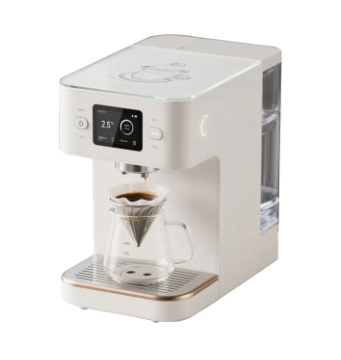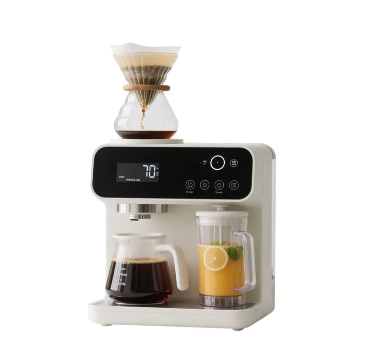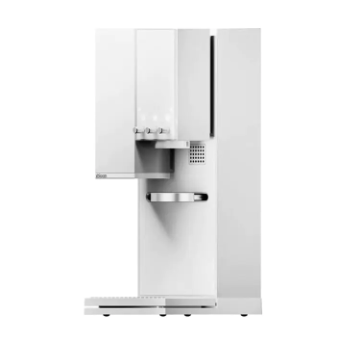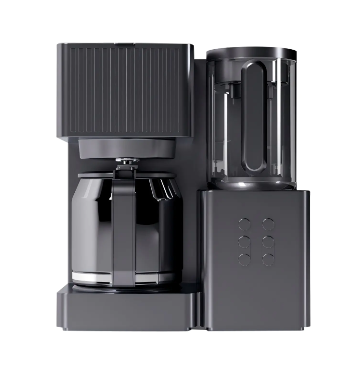1. Specialized brewing device: A coffee machine is an electrical appliance that uses heated water or steam to extract coffee powder, coffee capsules, or coffee beans. It can make various coffee beverages such as espresso, latte, and cappuccino in a short time.
2. Core functions: It includes a heating system, a pump pressure system, a filtration/extraction component, and a control panel. It can precisely control the temperature, pressure, and extraction time to ensure the stable flavor of coffee.
3. Applicable scenarios: From home kitchens to commercial coffee shops, offices, and even large - chain stores, coffee machines can meet different - scale coffee needs with their efficient and standardized brewing processes.
What are types and styles of coffee machines?
1. Drip (American) coffee machine

It allows hot water to slowly penetrate the coffee powder through gravity, which is suitable for making mild - flavored American coffee.
It has a simple structure and an affordable price, and is commonly found in homes and offices.
2. Capsule coffee machine

It uses pre - loaded capsules and can complete brewing with one button. It is easy to operate and has low cleaning costs.
It is suitable for users who pursue fast and stable - tasting coffee, especially in small - space environments.
3. Semi - automatic Italian coffee machine

It requires manual grinding, tamping of coffee powder, and extraction, providing more room for adjusting the coffee flavor.
It is suitable for coffee lovers and small coffee shops and can make fancy coffees such as espresso and cappuccino.
4. Fully automatic coffee machine

It integrates functions such as grinding, tamping of coffee powder, extraction, and steam milk frothing, and can make various coffees with one button.
It combines high efficiency and diversity and is widely used in commercial places and high - end homes.
Why does a coffee machine need a steam wand when making milk foam?
1. Steam heating and gas injection
The steam wand sprays high - temperature steam directly into the milk, causing the milk to heat up quickly and form fine bubbles, resulting in a dense milk foam.
2. Protein structure change
The hot steam denatures the casein and whey protein in the milk, forming a network structure that can capture and stabilize air, enhancing the volume and fineness of the milk foam.
3. Forming a vortex for uniform whipping
Tilting the steam wand at about 15° and placing it close to the wall of the milk pitcher can create a vortex, allowing the air to be evenly distributed in the milk, avoiding large bubbles and achieving a smooth "silk" texture.
4. Key temperature control
The ideal temperature for making milk foam is between 55 - 65 °C. The steam wand provides precise heat energy, enabling the milk to complete the two stages of "aeration" and "refinement" within this temperature range, ensuring a smooth taste without the bitterness caused by excessive protein denaturation.
What are the possible reasons when a coffee machine fails to start or has no water output, and how to quickly troubleshoot?
1. Power supply or control board failure
Check if the power plug, fuse, or power switch is working properly; if the machine does not respond, it may be due to a problem with the main control board or poor circuit contact.
After confirming the power supply, then check the water circuit.
2. Water tank or water circuit blockage
Confirm if there is enough water in the water tank and if the water level sensor is covered with scale; check if the water inlet pipe and filter are blocked by debris or scale.
If the water level in the water tank is normal but there is still no water output, remove the water outlet pipe, rinse it with clean water, or use a fine needle to unclog it.
3. Pump pressure system failure
Insufficient pump pressure will cause the water to fail to be pushed to the brewing head. Check if the pump makes abnormal noises or is completely silent.
If the pump is damaged, it needs to be replaced or you can contact a professional for repair.
4. Steam/heating element failure
If the heating element does not heat up, the machine cannot enter the brewing program. Check if the heating block is heating or if it is covered with scale.
After descaling, test again. If there is still no heat, the heating element may need to be replaced.
5. Quick troubleshooting process:
Power off and check the power supply, plug, and fuse;
Open the machine, check the water level in the water tank, and confirm that the water circuit is unobstructed;
Listen for the operation of the pump pressure. If there is no sound, it may be a pump failure;
If all the above are normal, try to reset the machine (long - press the power button). If it still does not respond, it is recommended to contact after - sales service.
How should you descale and deeply clean a coffee machine when the coffee it makes has a weak taste and less oil after long - term use?
1. Descaling (removing scale)
Use a special descaling agent: Add the descaling agent to the water tank according to the instructions and start the descaling program, which usually includes one descaling cycle and one rinsing cycle, taking about 30 minutes to complete.
Use vinegar or citric acid as an alternative: Mix white vinegar and water in a 1:6 ratio, pour it into the water tank, run the brewing cycle for 15 minutes, let it stand for 20 minutes, and then rinse it twice with clean water.
2. Deep cleaning (removing oil and coffee grounds)
Disassemble detachable parts: Remove the filter, coffee grounds container, steam wand, etc., and scrub them with warm soapy water to ensure there is no residual oil.
Clean the internal pipeline: Use a special cleaning agent or a coffee machine cleaning capsule (use once every 30 cups), let the cleaning liquid circulate inside to thoroughly flush the boiler and pipeline.
3. Maintenance of the steam wand and milk frothing system
Remove residues: Open the steam valve after each use to let the steam flush the nozzle, and then wipe it with a damp cloth.
Regular descaling: If the water output of the steam wand decreases or there is noise, it indicates that there is scale inside. Add a steam wand cleaning step to the descaling program.
4. Daily maintenance suggestions
Daily: Rinse the brewing head and milk frother, and pour out the remaining coffee grounds.
Weekly: Disassemble the filter and drip tray and clean them with warm water and a soft brush.
Monthly or every 3 - 6 months: Perform a complete descaling according to the frequency of use, using a descaling agent or an acetic acid solution.
Through the above steps, the extraction pressure and temperature control of the coffee machine can be restored, and the coffee can regain a rich taste and abundant oil.




 中文简体
中文简体 English
English 한국어
한국어 日本語
日本語 русский
русский Español
Español عربى
عربى




